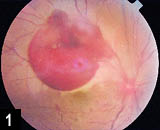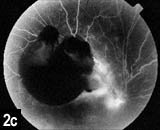Case report: Unique case including disc edema and large sub-ILM hemorrhage
Tortuous and telangiectatic vessels with localized arteriolar dilatations were also present.
|
|
A 30-year-old man presented to our retina and uvea services at ICARE Eye Hospital with a history of sudden, painless diminution of vision in the right eye of 1-day duration. He denied a history of floaters, flashes, trauma or similar self-limiting episodes. He had no history of recent febrile illness, constipation, lifting heavy weights or bouts of severe cough. There was no history of promiscuity, bleeding diathesis, alcoholism or hepatic disease.
His history was significant for a febrile illness in childhood with ocular involvement of the left eye for which some operative procedure was done, the details of which were not available, and he has had poor vision since then. The patient was a high myope wearing spectacles since the age of 15. He was not on any medication, nor did he have any drug allergies. He had a family history of tuberculosis, but the patient himself did not have any manifestations suggestive of Koch’s.
Examination
On ophthalmic examination, his best corrected visual acuity was 20/400 and counting fingers 1 m in the right eye and 2 m in the left eye. He had a left divergent squint. Slit-lamp examination of the right eye was within normal limits and there was no relative afferent pupillary defect. The left eye revealed an updrawn pupil with an adherent leukoma. Intraocular pressures by applanation tonometry were 16 mm Hg and 18 mm Hg in the right and left eye respectively. Gonioscopy by Goldmann 2 mirror revealed angles open up to the scleral spur, with heavy pigmentation in the right eye. The left eye revealed broad peripheral anterior synechiae superiorly. Remaining angle was open up to the scleral spur, with heavy trabecular meshwork pigmentation.
Dilated fundus examination revealed tortuous retinal vasculature with multiple aneurysmal dilatations. There were dot-and-blot hemorrhages scattered throughout the fundus. The disc was edematous and there was edema at the posterior pole. There was a large area (measuring 5 to 6 disc diameters) of sub-internal limiting membrane bleed just above the macula (figure 1) The left fundus showed a pale disc, no foveal reflex, attenuated vessels and attached retina.
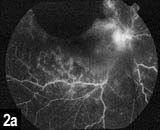 | 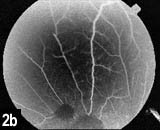 |
| Fundus fluorescein photograph (right eye) showing aneurysms at the posterior pole, disc and macular edema, vasculitis of the superotemporal vessel and a large area of blocked fluorescence just above the macula, suggestive of a large retinal hemorrhage (left). Fundus fluorescein photograph (right eye) showing marked variation in caliber of retinal vasculature in between aneurysms (right). A large area sub-ILM bleed is also seen. | |
Diagnosis
|
|
The differential diagnosis for a young, healthy adult with tortuous, telangiectatic vessels and multiple aneurysmal dilatations are diabetic and hypertensive retinopathy, sickle cell retinopathy, leukemic retinopathy, HIV retinopathy and Eales’ disease. Several other rare disorders like multiple myeloma, lupus retinopathy, retinopathy secondary to anoxia and carbon monoxide poisoning, radiation retinopathy, Leber’s miliary aneurysm and adult Coat’s disease can also cause such a retinopathy.
The presence of aneurysmal dilatations extending through the first several orders of arterial branching, localized arteriolar dilatations, disc edema and large sub-ILM hemorrhage made this case unique.
Nonproliferative diabetic retinopathy appears with dot-blot hemorrhages and exudates. The patient did not have diabetes or hypertension. He was also investigated thoroughly for sickle cell anemia, leukemia, HIV, multiple myeloma and systemic lupus erythrematosis, all of which were ruled out through various blood tests and systemic clinical examinations. There was no history of exposure to radiation.
Fundus fluorescein angiogram highlighted the aneurysms at the branching points of arteries, and were fusiform as well as spheroid in shape (figure 2a). In segments between the aneurysms, the retinal arteries showed marked variations in caliber. There was a large area of blocked fluorescence just above the macula, suggestive of a large retinal hemorrhage (figure 2b). There was leakage of dye at the optic nerve head; the macula was suggestive of disc and macular edema. In the temporal periphery the large arteries took a “dip,” suggestive of a distinct perfused and a nonperfused area. There was no area of active retinal vasculitis (figure 2c).
Studies to rule out any bleeding diathesis and liver disorders were also within normal limits.
Based on the fundus examination and typical fundus fluorescein angiographic features, a diagnosis of idiopathic retinal vasculitis, multiple arterial microaneurysms and neuroretinitis (IRVAN) was made.
An attempt to make an opening in the ILM with Nd:YAG laser and intravitreal gas injection failed to disperse the bleed. The patient was subjected to pars plana vitrectomy, ILM peeling, sub-ILM hemorrhage evacuation and endolaser. A large macroaneurysm was found under the sub-ILM hemorrhage, which was cauterized and barraged with laser.
On the first postoperative day, the patient had a visual acuity of 20/200 (figure 3). The macular edema persisted, for which he was treated with oral and topical steroids and was probably the reason for limited visual improvement. When last seen on the sixth postop week, the best corrected visual acuity was 20/20. The macular edema and retinal tortuosity had subsided (figure 4).
 | 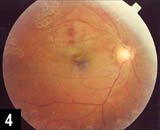 |
| (Left) Postop fundus photograph (right eye) showing a large macroaneurysm under the sub-ILM hemorrhage seen in the previous photographs, which was cauterized and barraged with laser. Late postop fundus photograph (right eye) shows good resolution of retinal hemorrhage, macular edema and retinal tortuosity (right). | |
Discussion
In 1995 Chang and colleagues reported 10 cases, with what was characterized as a new syndrome of IRVAN. Patients with similar findings have been reported in the past. Karel et al reported the fluorescein angiographic findings of a 15-year-old girl with multiple aneurysms and retinal vasculitis in 1973. Several other case reports were published describing similar patients. None of the reported patients had had any associated systemic findings.
Patients with IRVAN usually present with decreased visual acuity in one or both eyes. There may be a variable number of cells in the anterior chamber and the vitreous cavity. They may have disc swelling associated with multiple aneurysmal dilatations. The aneurysms are commonly found on or near the optic nerve, an atypical site for retinal artery aneurysms. The aneurysms are also often found at branching points of the arteries, and may be fusiform, Y-shaped or spheroid. In segments between the aneurysms, the retinal arteries frequently show marked caliber variations.
Retinal vascular sheathing may occur, but it is not a prominent feature of the disorder in most patients. In the retinal periphery, there is a variable amount of retinal nonperfusion, with obliteration of arteries, veins and retinal capillaries. If the ischemic load of the nonperfused area reaches a critical level, neovascularization occurs. In severely affected patients vitreous hemorrhage, apparently originating from neovascularization, can develop. Subretinal, intraretinal, sub-ILM or vitreous hemorrhage from a ruptured macroaneurysm can develop. Sub-ILM hemorrhage in IRVAN has not been reported in the literature.
Patients with IRVAN can also develop marked intraretinal lipid deposition, especially in the peripapillary and macular area and around the aneurysms, forming a circinate.
The syndrome’s striking ophthalmoscopic picture is not shared by any other disease. However, certain disease processes, both systemic and ocular, that can mimic this rare disorder need to be ruled out. These include idiopathic retinal vasculitis, senile retinal arterial macroaneuryms and Coat’s disease, especially adult Coat’s if it occurs in this age group.
The aneurysms of Coat’s disease usually involve more than one element of the vascular circuit, do not occur at arterial bifurcations and have greater amounts of intraretinal lipid deposition. The other retinopathies with systemic manifestations with similar features to IRVAN have already been discussed. In this context, periarteritis nodosa can also present in a similar manner, although it does not cause multiple retinal arterial macroaneurysms.
At present there is no apparent cause for IRVAN, but an immunopathogenic cause, possibly related to a yet-unknown viral antigen, may be the inciting event.
Useful ancillary tests include fluorescein angiography, which highlights the arteriolar abnormalities. Affected patients with IRVAN have been treated with corticosteroids in an attempt to reduce any inflammatory worsening, although morbidity of IRVAN results from chronic secondary changes such as persistent leakage from aneurysms and vitreous hemorrhage from neovascularization.
Sub-ILM bleed at the macula from a burst macroaneurysm is a rare cause of sudden loss of vision from this syndrome. Focal laser treatment to microaneurysms has been tried, as has argon laser photocoagulation to the peripheral areas of nonperfusion in patients with neovascularization. Vitrectomy with endolaser is performed in patients with vitreous hemorrhage.
This 30-year-old patient will be closely followed.
For Your Information:References:
- Surbhit Choudhry, MD, and Aarti S. Choudhry, MD, can be reached at ICARE Eye Hospital and Postgraduate Institute, E-3a, Sector 26, Noida, UP, India; (91) 255-5969 or 255-8274; fax: (91) 0120-255-6389; e-mail: icare@vsnl.com; Web site: www.icarehospital.org.
- Bigar F, Witmer R. Progressive aneurysmal retinal arteriopathy. Forschr Ophthalmol. 1983;79:488-491.
- Chang TS, Aylward W, et al. Idiopathic retinal vasculitis, aneurisms, and neuro-retinitis. The Retinal Vasculitis Study. Ophthalmology. 102:1089, 1995.
- Fechner C, Gaudric A, et al. Bilateral diffuse retinal arteritis with multiple ectasias. Bull Soc Ophthalmol Fr. 1985;85:973-974.
- Karel I, Peleaka M, Diaisova G. Fluorescein angiography in retinal vasculitis in children’s uveitis. Ophthalmologica. 1973;166:251-264.
- Kincaid J, Schatz H. Bilateral retinal arteritis with multiple aneurysmal dilations. Retina. 1983;3:171-178.
- Kohno T, Uchida H, et al. Ocular manifestations of adult T-cell leukemia/lymphoma. A clinicopathologic study. Ophthalmology. 1993;100:1794-1799.
- Lucarelli MJ, Pepose JS, et al. Immunopathologic features of retinal lesions in multiple sclerosis. Ophthalmology. 1991;98:1652-1656.
- Milan P, Clurana AJ, Boudet C. Bilateral retinal arteritis with multiple aneurysmal dilations. J Fr Ophthalmol. 1986;9:23.
- Morgan CM, Foster CS, et al. Retinal vasculitis in polyarteritis nodosa. Retina. 1986;6:205-209.
- 0wens SL, Gregor ZJ. Vanishing retinal arterial aneurysms: A case report. Br J Ophthalmol. 1992;76:637-638.

